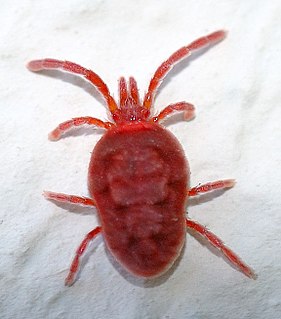
Mites are small arachnids.
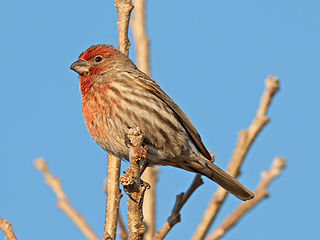
The house finch is a bird in the finch family Fringillidae. It is native to western North America and has been introduced to the eastern half of the continent and Hawaii. This species and the other "American rosefinches" are placed in the genus Haemorhous.

Xanthoria parietina is a foliose, or leafy, lichen. It has wide distribution, and many common names such as common orange lichen, yellow scale, maritime sunburst lichen and shore lichen. It can be found near the shore on rocks or walls, and also on inland rocks, walls, or tree bark. It was chosen as a model organism for genomic sequencing by the US Department of Energy Joint Genome Institute (JGI).
Vernon Ahmadjian was a distinguished professor at Clark University in Worcester, Massachusetts.—He specialized in the symbiosis of lichens, and wrote several books and numerous publications on the subject.
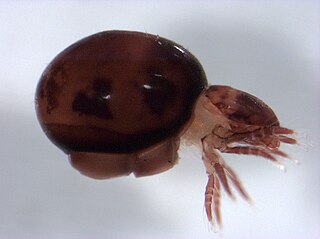
Oribatida, also known as oribatid mites, moss mites or beetle mites, are an order of mites, in the "chewing Acariformes" clade Sarcoptiformes. They range in size from 0.2 to 1.4 millimetres. There are currently 12,000 species that have been identified, but researchers estimate that there may anywhere from 60,000 to 120,000 total species. Oribatid mites are by far the most prevalent of all arthropods in forest soils, and are essential for breaking down organic detritus and distributing fungi.
Trebouxia is a unicellular green alga. It is a photosynthetic organism that can exist in almost all habitats found in polar, tropical, and temperate regions. It can either exist in a symbiotic relationship with fungi in the form of lichen or it can survive independently as a free-living organism alone or in colonies. Trebouxia is the most common photobiont in extant lichens. It is a primary producer of marine, freshwater and terrestrial ecosystems. It uses carotenoids and chlorophyll a and b to harvest energy from the sun and provide nutrients to various animals and insects.

Bryoria fremontii is a dark brown, hair-like lichen that grows hanging from trees in western North America, and northern Europe and Asia. It grows abundantly in some areas, and is an important traditional food for a few First Nations in North America.
Rhodacaridae is a family of mites in the order Mesostigmata.
Plateremaeidae is a family of oribatids in the order Sarcoptiformes. There are about 7 genera and 19 described species in Plateremaeidae.
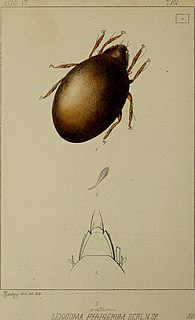
Liacaridae is a family of mites in the order Oribatida. There are about 7 genera and more than 240 described species in Liacaridae.

Hypochthonius is a genus of mites in the family Hypochthoniidae. There are about 10 described species in Hypochthonius.

Enarthronota is a suborder of mites in the order Oribatida. There are about 14 families and more than 450 described species in Enarthronota.
Mochloribatula is a genus of mites in the family Mochlozetidae. There are about eight described species in Mochloribatula.
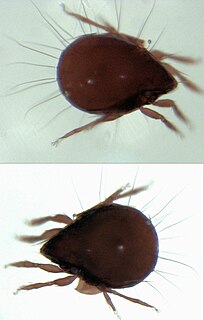
Oripodoidea is a superfamily of oribatids in the order Oribatida. There are about 19 families and at least 1,300 described species in Oripodoidea.
Exochocepheus is a genus of mites in the family Scutoverticidae. There are about seven described species in Exochocepheus.
Licneremaeoidea is a superfamily of mites in the order Oribatida. There are about 6 families and more than 170 described species in Licneremaeoidea.
John Walter Thomson Jr. (1913–2009) was a Scottish-born American botanist and lichenologist, sometimes referred to as the "Dean of North American Lichens".
Norton George Miller (1942–2011) was an American bryologist and paleobotanist. He was the president of the American Bryological and Lichenological Society from 1985 to 1987.

Punctelia rudecta, commonly known as the rough speckled shield or the speckleback lichen, is a North American species of foliose lichen in the family Parmeliaceae. This species can be readily identified by the light color of the thallus underside, the relatively large lobes at the edges of the thallus, and the tiny white pores present on the top of the thallus that are characteristic of the genus Punctelia. The lichen is quite abundant and widespread in the eastern and southeastern United States, although it also occurs in Canada and northern Mexico, but is less common in these regions. The lichen usually grows on bark, and less commonly on shaded rocks. There are several lookalike Punctelia species; these can often be distinguished from P. rudecta by differences in distribution or in the nature of the reproductive structures present on the thallus.
Carabodes higginsi is a species of mite in the family Carabodidae. Found in North America, it was described as a new species in 1988 by botanist Robert Gatlin Reeves. It occurs in the northeastern United States and in the Maritime Provinces of Canada. The mite is named after a friend of the author, Harold G. Higgins of Salt Lake City, Utah. A study conducted in New York that showed that the mite is one of several that takes shelter in the thallus of the common North American lichen Punctelia rudecta.








